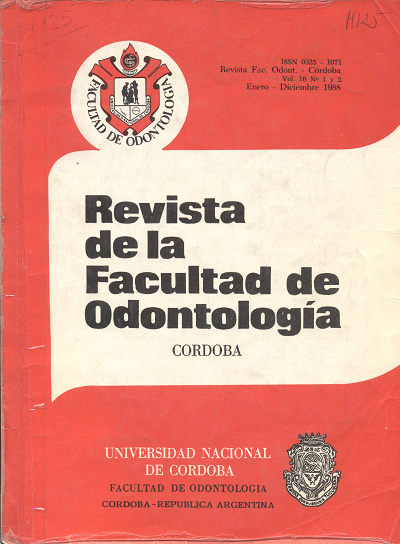Estudio comparativo de los mastocitos en glándulas salivales y ovarios durante el ciclo estrual
Palavras-chave:
Ciclo estrual, MastocitosResumo
La población mastocitaria de glándulas salivales se ve influenciada por la acción exógena de las hormonas sexuales, estrógeno y testosterona. (Ferraris y colab. 1986). El objetivo del presente trabajo fue estudiar los mastocitos en forma simultánea en glándulas salivales y ovarios durante el ciclo estrual, para observar las respuestas a la acción de las hormonas sexuales y establecer comparaciones entre ambos Órganos. Se usaron 24 ratas Wistar hembras adultas jóvenes •. Se determinaron las etepas del ciclo. Se disecaron las glándulas submaxilar (GSM) sublingual (GSL) y ove río, fijándose en formol tamponado y procesando según técnica de rutina. Colore dones usadas: ATO pH 3, 8; AB pH 2, 5, FAS. HISTOMETRIA: Se realizó en un área de 15,6 mm2 a 450 A, con un total de 10 lecturas de cada tejido examinado, áreas periductales y parénquima salival y en ovario: médula, hilio y oviducto.Durante el ciclo estrual se observaron en ambos Órganos: 1 °-Variaciones en el comportamiento citoquímico y tamaño celular de los mastocitos especialmente en las etapas del proestro y estro. 2 °-La GSM en el estro presenta un incremento de mastocitos que es estadísticamente significativo con respecto a las otras etapas. Este hecho se presenta similar en ovario. "Se concluye que durante el ciclo estrual los mastocitos sufren modificaciones citoquímicas y numéricas".
Referências
The mast cell polulation of salivary glands is considered to be influenced by the exogenous action of sexual hormones, estrogem and testosterone. (Fen•aris y colab. 1986). The aim of this work was to study the mast cells simultaneously in both salvary gland and ovaries during the oestrus cycle in order to observe the responses to the action of sexual hormones as well asto establish comparisons between both organs. Z4 female adult Wistar rats were used. The stages oí the cicle were dete!:mined. The submaxilary glands, sublingual glands and ovaries were dissected, they were fixed in formol and processed according to routinary technique. The used stain were: ATO pH 3, 8; AB pH Z, 5, PAS. HISTOMETRY: it was made in an area from 15,6 mmZ to 450 with a total oí ten lectures for each exa mined tissue; periductal areas and salivary parenchyma and in ovary: marrow h}lious and oviduct. During the oestrus cycle it was observed in both organs: 1 °-Variations in the cytocheminal behaviour and cellular size of mast cells mainly in the proestrus and oestrus stages. Z0 -In the oestrus the SMG shows an increase of mast cells which is statistically relevant with respect to the other stages. This fact is similar in ovary. The conclusion is that mast cells undergo cytocheminal and numerical modifications during the oestrus cycle".
Downloads
Publicado
Edição
Seção
Licença
Aquellos autores/as que tengan publicaciones con esta revista, aceptan los términos siguientes:
- Los autores/as conservarán sus derechos de autor y garantizarán a la revista el derecho de primera publicación de su obra, el cuál estará simultáneamente sujeto a la Licencia de reconocimiento de Creative Commons que permite a terceros:
- Compartir — copiar y redistribuir el material en cualquier medio o formato
- La licenciante no puede revocar estas libertades en tanto usted siga los términos de la licencia
- Los autores/as podrán adoptar otros acuerdos de licencia no exclusiva de distribución de la versión de la obra publicada (p. ej.: depositarla en un archivo telemático institucional o publicarla en un volumen monográfico) siempre que se indique la publicación inicial en esta revista.
- Se permite y recomienda a los autores/as difundir su obra a través de Internet (p. ej.: en archivos telemáticos institucionales o en su página web) después del su publicación en la revista, lo cual puede producir intercambios interesantes y aumentar las citas de la obra publicada. (Véase El efecto del acceso abierto).

